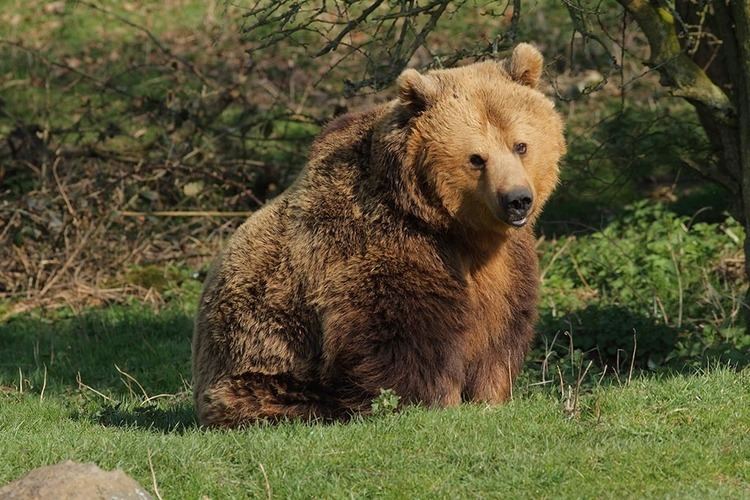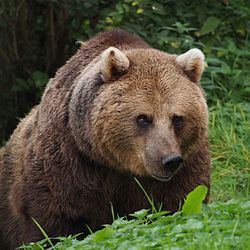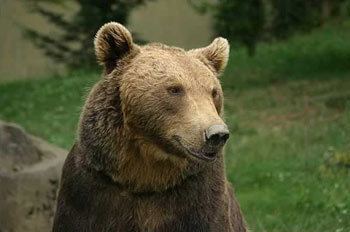Genus Ursus Higher classification Brown bear | Phylum Chordata Family Ursidae Scientific name Ursus arctos arctos Rank Subspecies | |
 | ||
Mass Male: 260 – 360 kg (Adult), Female: 150 – 250 kg (Adult) Similar Brown bear, Bear, Bears, Mammal, Kamchatka brown bear | ||
Eurasian brown bears
The Eurasian brown bear (Ursus arctos arctos) is one of the most common subspecies of the brown bear, found across Eurasia. The Eurasian brown bear is also known as the common brown bear, European brown bear, European bear and colloquially by many other names. "The genetic diversity of present-day brown bears (Ursus arctos) has been extensively studied over the years and appears to be geographically structured into five main clades based upon analysis of the mtDNA."
Contents
- Eurasian brown bears
- Eurasian brown bear mother and cubs digging in transylvania 01 07 14
- Description
- History
- Species origin
- Distribution
- Cultural depictions
- References

Eurasian brown bear mother and cubs digging in transylvania 01 07 14
Description

The Eurasian brown bear has brown fur, which can range from yellow-brownish to dark brown, red brown, and almost black in some cases; albinism has also been recorded. The fur is dense to varying degree and the hair can grow up to 10 cm in length. The shape of the head is normally quite round with relatively small round ears, a wide skull and a mouth equipped with 42 teeth, including predatory teeth. It has a powerful bone structure and large paws equipped with claws that can grow up to 10 cm in length. The weight varies depending on habitat and time of the year. A full grown male weighs on average 250 and 300 kilograms (550 and 660 lb). And reaches a weight of 481 kg (1,058 lb) and was nearly 2.5 m (8.2 ft) long. Females typically range between 150–250 kg (330–550 lb).
History

Brown bears were present in Britain until no later than 1000 AD, when they were exterminated through over hunting.

Eurasian brown bears were used in Ancient Rome for fighting in arenas. The strongest bears apparently came from Caledonia and Dalmatia.
In antiquity, the Eurasian brown bear was largely carnivorous, with 80% of its diet consisting of animal matter. However, as its habitat increasingly disappeared, meat consisted of only 40% of its dietary intake in the late Middle Ages, until modern times where meat now makes up little more than 10–15% of its diet. Whenever possible the brown bear will consume sheep.
Unlike in North America, where an average of two people a year are killed by bears, Scandinavia only has records of three fatal bear attacks in the last century.
Species origin
The oldest fossils are from the Choukoutien, China, about 500,000 years ago. It is known from mtDNA studies that during the Pleistocene ice age it was too cold for the brown bear to survive in Europe with the exception of three places—Russia, Spain, and in the Balkans.
Modern research has made it possible to track the origin of the subspecies. It is difficult to tell anything about the Eurasian brown bear, but the species to which it belongs developed more than .5 million years ago. Researchers have found that the Eurasian brown bear was separated about 850,000 years ago, one branch based in Western Europe and the other branch in Western Europe, Russia, Eastern Europe and Asia. Through research of mitochondrial DNA (mtDNA) researchers have found that the European family has been divided into two clades, one in the Iberian Peninsula and also the Balkans and the other in Russia.
There a population in Scandinavia that includes bears of the western and eastern lineages. By analyzing the mtDNA of the southern population researchers have found that they probably have come from populations in the Pyrenees in Southern France and Spain and the Cantabrian Mountains (Spain). Bears from these populations spread to southern Scandinavia after the last ice age. The northern bear populations originate from the Finnish/Russian population. Their ancestors probably survived the ice age in the ice-free areas, west of the Ural Mountains, and thereafter spread to Northern Europe.
Distribution
Although their inclusion as of Least Concern on the 2006 IUCN Red List of Threatened Species refers to the global species, not to the Eurasian brown bear specifically, local populations are becoming increasingly scarce. And as the IUCN itself adds:
"Least Concern does not always mean that species are not at risk. There are declining species that are evaluated as Least Concern."
Brown bears could once be found across most of northern Eurasia.
The brown bear has long been extinct in Ireland and Britain, but it still exists in Northern Europe and in Russia. There is a small but growing population (at least 35 bears) in the Pyrenees, on the border between Spain and France, which was once on the edge of extinction, as well as two subpopulations in the Cantabrian Mountains in Spain (amounting to around 250 individuals). There are also populations in the Abruzzo, South Tyrol and Trentino regions of Italy, totalling around one hundred bears.
Populations in Baltoscandia are steady and slowly increasing – they include over 2000 bears in Sweden, another 1200 in Finland, 700 in Estonia and around 70 in Norway.
Large populations can be found in Romania (around 6000 individuals, Slovakia (700-900 ), Bosnia and Herzegovina, Croatia (1200, Slovenia (500-700 ), Macedonia, Bulgaria, Poland, and Georgia; smaller, but still significant populations can also be found in Albania, Greece, Serbia and Montenegro; in 2005, there were an estimated 200 in Ukraine; these populations are part of two distinct metapopulations: the Carpathian (over 5,000 individuals), and the Dinaric-Pindos (Balkans), with around 3,000 individuals.
The largest brown bear population in Europe can be found in Russia; it has now recovered from an all-time low caused by intensive hunting.
Globally, the largest population is found east of the Ural mountain range, in the large Siberian forests; brown bears are also present in smaller numbers in parts of central Asia (former Soviet states).
Other clades of brown bear persist in small, isolated and for the most part highly threatened populations in Turkey, Iran, Afghanistan, Pakistan, parts of northwest India, central China, and on the island of Hokkaidō in Japan.
Cultural depictions
The historic distribution of bears and the impression it made on people has been reflected in the names of a number of localities (some notable examples include Berlin, Bern, Medvednica and Ayu-Dag), as well as personal names—for example, Xiong (熊), Bernard, Arthur, Ursula, Urs, Ursicinus, Orsolya, Björn, Nedved, Medvedev and Otso. The constellations Ursa Major and Ursa Minor are named for bears.
Bears of this subspecies appear very frequently in the fairy tales and fables of Europe, in particular tales collected by Jakob and Wilhelm Grimm. The European Brown Bear was once common to Germany and alpine lands like Northern Italy, Eastern France, and most of Switzerland, and thus appear in the tales of various dialects of German.
The bear is traditionally regarded as the symbol of the Russian (military and political) might; it is also Finland's national animal; and in Croatia, a brown bear is depicted on the reverse of the Croatian 5 kuna coin, minted since 1993.
